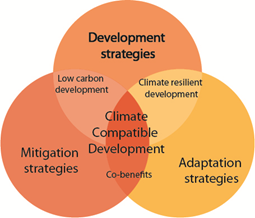Fiona Nunan is Lecturer in Environment and Development in IDD, specialising in natural resource governance and management in developing country settings, particularly within inland fisheries and coastal locations in East and Southern Africa, and in exploring the links between poverty and the environment.
As the 19th Conference of Parties of the United Nations Framework Convention on Climate Change meets (11th – 22nd November 2013) in Warsaw, building adaptation capacity within the context of development must be firmly on the agenda. Approaches such as ‘climate-smart development’, ‘low carbon development’ and ‘climate compatible development’ reflect a desire to bring together efforts to reduce emissions of greenhouse gases and increase storage or sinks for carbon dioxide, increase adaptive capacity and develop adaptation strategies, and to reduce poverty. Whilst these approaches are attractive, questions remain as to how far these objectives can be tackled together.
Climate compatible development
“Development that minimises the harm caused by climate impacts, while maximising the many human development opportunities presented by a low emissions, more resilient, future” (Mitchell and Maxwell 2010).
This approach to development is advocated by the Climate and Development Knowledge Network (CDKN), the funders of this research.

Climate Compatible Development
Reproduced from Mitchell and Maxwell (2010)
Our research in Sri Lanka and Kenya on the potential for climate compatible development in coastal areas has identified a range of policy mechanisms that already exist, or could be fairly readily adopted, that could contribute towards achieving these multiple goals.
Climate change presents considerable challenges for coastal areas, which are already under significant pressure from diverse sources and are often sites of contestation, with competing, and at times conflicting, demands for the use of land, extraction of natural resources and access to beaches and fishing grounds. The impacts of climate change will magnify and deepen such challenges, presenting an urgent need for adaptation strategies for local and national populations. Coastal ecosystems also present extensive opportunities for climate change mitigation through carbon capture and storage, as well as being important areas for livelihoods and economic development.
Examples of packages mechanisms for CCD
Multiple policy instruments and approaches already exist that could support the delivery of CCD in coastal areas including:
- Integrated coastal zone management
- Climate change mainstreaming
- Payments for ecosystems services schemes
- Protected area status
- Environmental impact assessment and strategic environmental assessment
- Collaborative forms of natural resource management.
To strengthen the potential of delivering on CCD, such mechanisms could be brought together as a package of complementary measures to enable delivery on mitigation, adaptation and development. Examples of such packages are:
1. Integrated coastal zone management/collaborative forms of natural resource management/ protected area status/climate change mainstreaming
ICZM very often involves the participation of coastal communities, but there may be multiple forms of collaborative natural resource management that could be coordinated for a more effective, integrated approach. Protected area status can strengthen the mitigation and adaptation potential of coastal ecosystems and contribute to improved livelihoods. ICZM can strengthen the resilience of ecosystems to climate change as well as carbon storage potential.
2. Payments for ecosystem services/collaborative forms of natural resource management/ protected area status/climate change mainstreaming
Community-based PES schemes require a form of collaborative natural resource management between communities and relevant government departments, with appropriate policy and legal support. Protected area status and climate change mainstreaming can strengthen the contribution of PES to mitigation and adaptation, and, with a strong poverty orientation in the design, to improved livelihoods.
3. Land-use planning/EIA and SEA/climate change mainstreaming
As there are very often multiple land uses and demands in coastal areas, land-use planning systems have the potential to make a real difference to the resilience of coastal areas to climate change and to the mitigation potential of coastal ecosystems. Land-use planning also has significant effects on local livelihoods – in both positive and negative ways. Bringing together land use planning with strategic environmental assessment and climate change mainstreaming could result in a much more holistic, resilient approach to planning for CCD.

Kalpitiya Lagoon, Sri Lanka (photo credit: Priyantha Kumara)
What does policy need to promote CCD in coastal areas?
To enable such mechanisms, or packages of mechanisms, to deliver on CCD in practice, significant leadership is needed to bring people and ideas together across sectors and between stakeholder groups. In particular, what would be needed includes:
- Coordinated policy across sectors, which include environment, climate change, land use planning and forestry.
- Strengthened integrated management of coastal areas, including measures to mitigate and adapt to climate change and to reduce poverty of local people.
- Effective participation of coastal communities in governance structures and processes, with strengthened and coordinated collaborative management.
- Implementation of existing policy, with the resources (financial, technical and political will) to support implementation.
Clearly the potential is there for climate compatible development to happen in coastal areas, but a genuinely coordinated and integrated approach to policy and management is needed, with effective participation of a range of stakeholders, including local users of natural resources, and financial resources to ensure implementation.
This blog is an output from a project funded by the UK Department for International Development (DFID) and the Netherlands Directorate-General for International Cooperation (DGIS) for the benefit of developing countries. However, the views expressed and information contained in it are not necessarily those of or endorsed by DFID, DGIS or the entities managing the delivery of the Climate and Development Knowledge Network, which can accept no responsibility or liability for such views, completeness or accuracy of the information or for any reliance placed on them.
